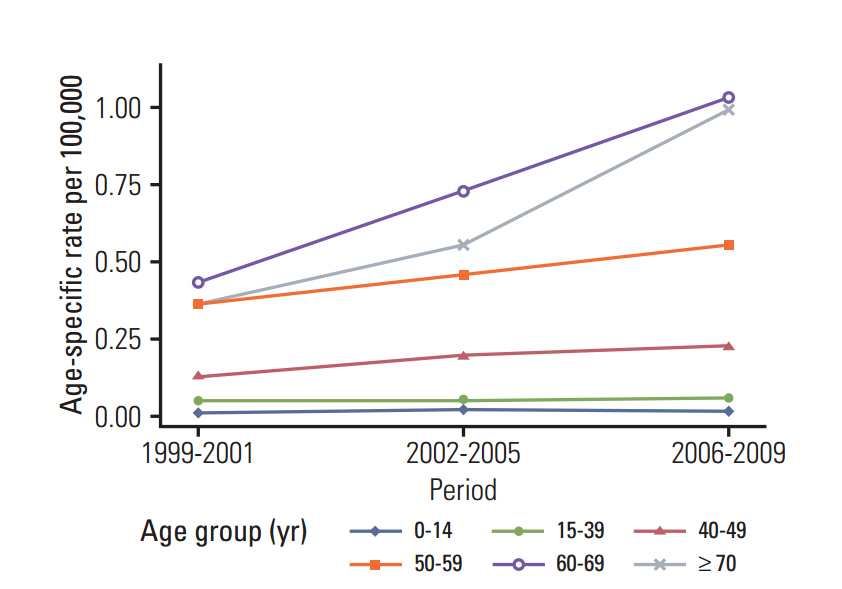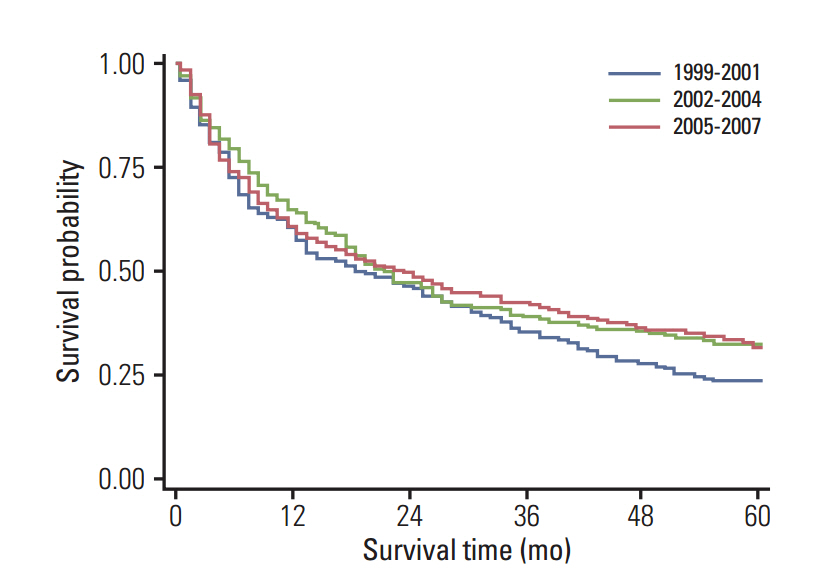Cancer Res Treat.
2015 Oct;47(4):569-574. 10.4143/crt.2014.085.
Population-based Incidence and Survival for Primary Central Nervous System Lymphoma in Korea, 1999-2009
- Affiliations
-
- 1Neuro-Oncology Clinic, National Cancer Center, Goyang, Korea. heonyoo@ncc.re.kr
- 2The Korea Central Cancer Registry, National Cancer Center, Goyang, Korea. astra67@ncc.re.kr
- KMID: 2403373
- DOI: http://doi.org/10.4143/crt.2014.085
Abstract
- PURPOSE
Primary central nervous system lymphoma (PCNSL) is an uncommon brain tumor accounting for 2%-5% of all primary brain tumors. Few population-based analyses of survival for patients with PCNSL have been conducted, particularly in Asian countries.
MATERIALS AND METHODS
Using the Korea National Cancer Incidence Database, 1,062 cases of PCNSL newly diagnosed from 1999 to 2009 were analyzed. The crude rate, age-standardized rate (ASR), and annual percent change were calculated. To estimate the observed survival, we restricted the data to between 1999 and 2007 and followed the cases until December 2010. The overall survival was estimated using the Kaplan-Meier method, and piecewise Poisson regression model.
RESULTS
The ASR for PCNSL between 1999 and 2009 was 0.17 per 100,000, and the annual percent change from 1999 to 2009 was 8.8% (p < 0.001). The ASR of males was higher than that of females, and the older groups (60s or over) showed the largest increase in incidence rates. For all ages, the five-year survival from PCNSL was 29.9% between 1999 and 2007. Survival from PCNSL is known to show strong association with age at diagnosis.
CONCLUSION
These results are similar to those of previous studies. Our findings may be helpful to clinicians and patients in determining long-term prognoses for PCNSL.
Keyword
MeSH Terms
Figure
Reference
-
References
1. Freeman C, Berg JW, Cutler SJ. Occurrence and prognosis of extranodal lymphomas. Cancer. 1972; 29:252–60.
Article2. Olson JE, Janney CA, Rao RD, Cerhan JR, Kurtin PJ, Schiff D, et al. The continuing increase in the incidence of primary central nervous system non-Hodgkin lymphoma: a surveillance, epidemiology, and end results analysis. Cancer. 2002; 95:1504–10.3. Schlegel U, Schmidt-Wolf IG, Deckert M. Primary CNS lymphoma: clinical presentation, pathological classification, molecular pathogenesis and treatment. J Neurol Sci. 2000; 181:1–12.
Article4. Eby NL, Grufferman S, Flannelly CM, Schold SC Jr, Vogel FS, Burger PC. Increasing incidence of primary brain lymphoma in the US. Cancer. 1988; 62:2461–5.
Article5. Jung KW, Yoo H, Kong HJ, Won YJ, Park S, Lee SH. Population-based survival data for brain tumors in Korea. J Neurooncol. 2012; 109:301–7.
Article6. Curado MP, Edwards B, Shin HR, Storm H, Ferlay J, Heanue M, et al. Cancer incidence in five continents, Vol. IX. IARC Scientific Publications, No. 160. Lyon: International Agency for Research on Cancer;2007.7. Forman D, Bray F, Brewster D, Gombe Mbalawa C, Kohler B, Pineros M, et al. Cancer incidence in five continents, Vol. X [Internet]. Lyon: International Agency for Research on Cancer;2014. [cited 2015 Feb 10]. Available from: http://ci5.iarc.fr.8. Segi M, Fujisaku S. Cancer mortality for selected sites in 24 countries (1950-1957). Sendai: Tohoku University School of Medicine;1960.9. Altekruse SF, Kosary CL, Krapcho M, Neyman N, Aminou R, Waldron W, et al. SEER cancer statistics review, 1975-2007. Bethesda, MD: National Cancer Institute;2010.10. Ney DE, Reiner AS, Panageas KS, Brown HS, DeAngelis LM, Abrey LE. Characteristics and outcomes of elderly patients with primary central nervous system lymphoma: the Memorial Sloan-Kettering Cancer Center experience. Cancer. 2010; 116:4605–12.11. Ferreri AJ, Blay JY, Reni M, Pasini F, Spina M, Ambrosetti A, et al. Prognostic scoring system for primary CNS lymphomas: the International Extranodal Lymphoma Study Group experience. J Clin Oncol. 2003; 21:266–72.
Article12. Mocroft A, Katlama C, Johnson AM, Pradier C, Antunes F, Mulcahy F, et al. AIDS across Europe, 1994-98: the EuroSIDA study. Lancet. 2000; 356:291–6.
Article13. Sacktor N, Lyles RH, Skolasky R, Kleeberger C, Selnes OA, Miller EN, et al. HIV-associated neurologic disease incidence changes: Multicenter AIDS Cohort Study, 1990-1998. Neurology. 2001; 56:257–60.
Article14. Schaller C, Kelly PJ. Primary central nervous system non-Hodgkin's lymphoma (PCNSL): does age and histology at presentation affect outcome? Zentralbl Neurochir. 1996; 57:156–62.15. Hochberg FH, Miller DC. Primary central nervous system lymphoma. J Neurosurg. 1988; 68:835–53.
Article16. O’Neill BP, Tomlinson FH, O’Fallon JR, Scheithauer BW, Kurtin PJ, O'Neill DB, et al. The continuing increase of primary central nervous system non-Hodgkin’s lymphoma. Ann Neurol. 1993; 34:313.17. Jung KW, Won YJ, Kong HJ, Oh CM, Seo HG, Lee JS. Cancer statistics in Korea: incidence, mortality, survival and prevalence in 2010. Cancer Res Treat. 2013; 45:1–14.
Article
- Full Text Links
- Actions
-
Cited
- CITED
-
- Close
- Share
- Similar articles
-
- Primary Non-Hodgkin ''s Lymphoma Involving the Third Ventricle: A Case Report
- Primary Central Nervous System Lymphoma Mimicking Behcet's Disease
- Recent advances in the management of primary central nervous system lymphoma
- A Case of Primary B-cell Lymphoma of the Centrol Nervous System after Renal Transplantation: A Case Report
- A Case of Panhypopituitarism and Central Diabetes Insipidus Caused by Primary Central Nervous System Lymphoma






